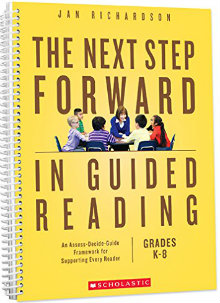The Next Step Forward in Guided Reading
The Next Step Forward in Guided Reading: An Assess-Decide-Guide Framework for Supporting Every Reader
By Jan Richardson, Ph.D.
(Scholastic, 2016 – Learn more)

When it comes to literacy instruction, Jan Richardson’s Assess-Decide-Guide framework presented in The Next Step Forward in Guided Reading is one of the most important concepts I have read. I wish it had been available when I did my undergraduate work over a decade ago!

The videos are always shot after the students have been able to fully master the skills and routines, making me feel like a failure when I can’t get my 28 fourth graders to sit down and read in one place for five minutes, let alone 20!
While the videos that Dr. Richardson includes with her book still make me feel that way, I think the strategies that she suggests will better help me reach that how point.
Select the sections you need
The Next Step Forward in Guided Reading can be broken down into four sections. Unlike many professional texts I have read, this is a resource book that does not require you to read the previous sections to understand what is being discussed. In fact, it’s spiral-bound and very much set up so that you can go to the relevant pages, read what you need to know, and put the recommendations into practice right away!
The first part is an introduction to guided reading and is comprised of the Introduction and Chapter 1. In these first 25 pages, Richardson tells you everything you (probably) already know about guided reading – the what and the why of this very widely accepted practice. If you aren’t familiar with it, though, this is a great overview and will help you get started.
The next section, which is by far the largest (comprising Chapters 2 through 6), presents strategies for teaching students at the different levels of reading ability (Pre-A, Early, Emergent, Transitional, Fluent). Each chapter provides a profile of typical reading and writing abilities of students at these different stages, but it is important to keep in mind that these are generalized descriptors and are not meant to be all inclusive and comprehensive. Richardson then gives suggestions for useful formative assessments related to reading and writing so that you can best decide what to teach in your guided reading lessons.
These chapters are where you get down to the nuts and bolts of guided reading lessons, with sample lesson plans, explanations of each component, resource materials, and ways to differentiate for various student needs. At the end of the chapter is a brief FAQ with suggestions on how to tackle common problems and help students appropriately move from one phase to the next.
For a teacher, all you need to do is find the chapter relevant to your students and read that part closely, taking lots of notes and jotting down ideas for how to incorporate what you find. Just remember that, even if most of your students are transitional readers, you will have students at different stages. This book will give you the strategies and structure you need to make sure you are meeting the instructional needs of all students. You should definitely use this information when collaborating with reading interventionists, special education teachers, and other specialists.
Useful to administrators as well as teachers
For a principal or other school leader, skimming through these chapters will call to mind useful teaching strategies and points to look for when observing guided reading. These chapters will also help both teachers and administrators have meaningful, productive conversations about best practices in guided reading and what supports are needed to help students continue to progress.
While the lessons in Chapters 2 through 6 are purposefully designed to be just outlines, the next section of this book presents 29 detailed lesson modules that can be used to teach 12 core comprehension strategies. I could see using these as whole-class mini-lessons during the first half of the year, introducing one strategy each week to my intermediate students.
I worry, however, that they may be too much for readers who are struggling with comprehension, and I would have to make sure that I use guided reading lessons to help them hone in on a few key strategies, even as I continue to introduce new strategies to students as a whole.
How to do guided reading well
As an experienced teacher who has been in a building where guided reading has been the focus of professional development for over six years, the last section of this book, the Appendices, is the most useful, along with the teacher’s companion and the digital versions of all of the forms. The book itself is an explanation of how to do guided reading; the appendices give you the resources to do it well.
I am looking forward to digging deeper into this book as I discuss it with colleagues and make plans for implementing Jan Richardson’s framework into our guided reading instruction so that all of our students can become successful readers, writers, and consumers of information.
Alex T. Valencic, Ed.M., is a fourth grade teacher in Urbana, Illinois. He has taught professionally for nine years. When not teaching, Valencic can be found reading, riding his bicycle, volunteering with the Boy Scouts of America, Operation Snowball, Inc., and the Cebrin Goodman Teen Institute, or spending time with his family. You can learn more about his adventures in teaching fourth grade by visiting his blog at http://teachingfourth.wordpress.com or by following him on Twitter @alextvalencic.




































Hi! I’m trying to find a list of books that are suggested to use with the lessons in this guided reading resource. I’m thinking of buying this book, but wanted to see which children’s books are used to see how many I already have. Any help would be appreciated!
Hi Emily! Great question! I wanted to double-check my copy of Next Step Forward before replying; Jan does not provide any specific suggestions for texts. She intentionally wrote this book and designed her framework so that it can work with any text a teacher may choose to use. She does suggest the Scholastic Short Reads for Guided Reading collection, but they are in no way required. I hope that helps!